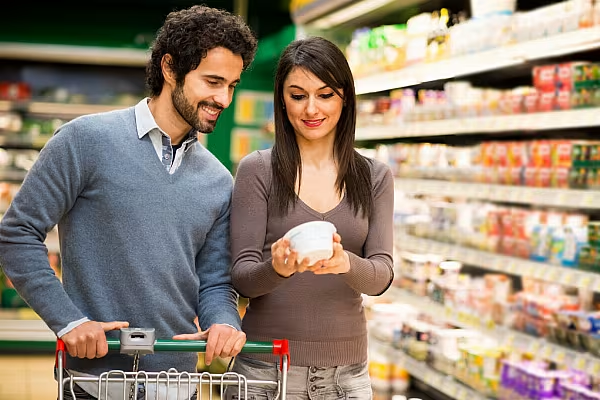Health and wellbeing are clearly very important to European shoppers, but being able to make healthy choices means understanding the nutritional benefits of the food and drink that is on offer. Currently, though there is little consistency in the approach to communicating nutritional values across Europe. IRI’s Olly Abotorabi considers whether this is an area that food and drink manufacturers could turn to their advantage.
IRI’s European Shopper Survey recently identified that 51% of EU shoppers felt wellness was important to them. Over a quarter were looking to lose weight while 15% were mindful of health problems.
Consumers understand that there is a link between health, wellness and nutrition. Earlier this year, IRI Italy presented headline findings from a study on nutrition to the EU Commission and highlighted that 92% of local consumers recognised the importance of controlling fats, salt and sugar levels to maintain or enhance wellness.
Varying Standards
But understanding the labelling on food and drink packaging has never been more confusing. Whilst the European Commission has made back of pack nutritional labelling mandatory for pre-packed foods, front of pack nutritional labelling remains voluntary.
Analysis conducted recently by IRI across key European countries reveals that the implementation of standards for front of pack nutritional labelling is currently extremely varied.
The labelling system used across the Nordic countries of Sweden, Denmark and Norway is voluntary and one of the longest-running labelling approaches used in Europe. Under their 'keyhole system', labels are granted to packaged and restaurant foods that adhere to its standards on fat, sugar, salt and fibre.
In Norway, there was a five-fold increase in the number of products using the system between 2009-2015, while in Sweden a 10% decrease in calorie intake was identified when consumers consistently chose foods with keyhole labels.
The UK has used a front of pack 'traffic light' system since 2013, which uses coloured ratings across five macro-nutritional values, designed to easily indicate the status of each nutritional value. Implementation, however, in the UK is inconsistent and confusion reigns – according to a recent survey by the British Nutrition Foundation, 40% of consumers find it difficult to make informed healthy food choices.
In France, the Nutri-Score system was introduced in 2017. It generates ratings from A to E based on the global nutritional value of products. Resistance has been felt by both international and local brand manufacturers, implying it is ‘too dismissive’.
Leading retailer Leclerc however revealed that in a preliminary analysis of 300,000 Drive (click and collect) shoppers, the nutritional values of their basket rose by 10% on average when presented with the option of Nutri-Score products.
Open To Interpretation
The way that nutritional values are measured is another issue at play here, for example whether to use weight or portion values – which in itself can be interpreted in variable ways.
Evolved Nutritional Labelling (ENL), an adaptation of the UK traffic light system, was proposed to the EU Commission in May 2018 by five leading multinational brand manufacturers using measurement by portion. This has attracted criticism for limiting the ease of comparison and the fact that it can be adjusted by product type to avoid red light labels on the front of pack – if consumers aren’t able to accurately stick to the portion size suggested it could mean over consumption for those products that are higher in fat, sugar and salt.
Greater consistency in the deployment of front of pack labelling is visible across EU private label ranges. Retailer own brand products have strengthened their share across key western EU markets in the last year, accounting for 40% of IRI EU Grocery value.
Taking the lead on nutritional labelling, providing greater ease of comparison and transparency, will only serve to strengthen growing credentials with EU shoppers.
Third-Party Solutions
If brand manufacturers don’t take control of their communications around nutrition soon, they might find third-parties filling the gap for simple, helpful information. Shoppers have more information than ever before at their disposal by way of smart phone apps to help them understand more about the food they eat.
A prime example is Yuka, available in France, which comes with guidance and recommendations on healthy products at the scan of a barcode, helping influence consumers’ choices in store or on screen.
Currently, there is a window of opportunity for manufacturers to help consumers make healthier choices with clearer and more consistent nutritional labelling, but that chance for voluntary action might not be there forever, the European Commission has already had a first meeting on this issue in April 2018. With the guideline daily amount (GDA) already a uniform label across EU, opportunity exists to agree a unified approach.
Meeting Demand
European shoppers want to be healthier and the chance is there for manufacturers to help them with a consistent labelling template. Looking forward, greater acceptance of front of pack nutritional labelling could prove influential in bringing healthier products to store and result in boosting brand equity with shoppers.
Evidencing front of pack label impact could prove decisive, and sway other countries to adopt and alter the path to an eventual consensus in the region. Ultimately this could become a win-win for manufacturers and retailers alike, they just need to realise this potential.
Brands need to demonstrate ownership on communications about nutritional values now, or risk losing control forever.
© 2018 European Supermarket Magazine – your source for the latest retail news. Article by Stephen Wynne-Jones. Click subscribe to sign up to ESM: The European Supermarket Magazine.














